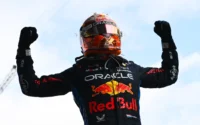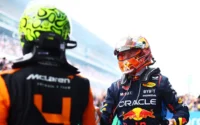The Circuit de Barcelona-Catalunya, located in Montmeló, near Barcelona, is known for its long straights, range of corners and large fan capacity that can accommodate over 140,000 spectators in its stands.
Originally known as the Circuit de Catalunya, the track’s name was altered in 2013 following a sponsorship agreement with the Barcelona City Council. This led to the inclusion of ‘Barcelona’ in the circuit’s title.
Circuit de Barcelona-Catalunya
| First Grand Prix | 1991 Spanish Grand Prix |
| Number of Laps | 66 |
| Circuit Length | 4.657km |
| Race Distance | 307.236 km |
| Lap Record | 1:16.330 Max Verstappen (2023) |
Circuit
When was the Circuit de Barcelona-Catalunya built?
The Circuit de Barcelona-Catalunya, constructed in 1991, quickly established its presence in motorsports by hosting the Spanish Grand Prix in the same year. The timing of the circuit’s construction was strategically aligned with a significant international event, the Olympic Games, which were set to be held in Barcelona in 1992.
The circuit’s inauguration marked its entry into the Formula 1 calendar and coincided with Barcelona’s preparations for the upcoming Olympic Games. This alignment showcased the circuit as a multifunctional sports venue capable of hosting various sporting events, from touring cars to Moto GP and F1. During the 1992 Olympic Games, the Circuit de Barcelona-Catalunya played a significant role, serving as the start and finish line for the road team time trial cycling event.
This dual function of the circuit during its early days highlighted its versatility and the foresight in its design and construction. It was able to accommodate both high-speed motorsport events and Olympic-level cycling competitions, a testament to its well-thought-out infrastructure and facilities.
The Circuit de Barcelona-Catalunya’s entry to the Formula 1 calendar and its involvement in the Olympics was important not just for the circuit but also for Barcelona and Catalonia. It helped to elevate the area’s status as a centre for international sports and contributed to the legacy of the 1992 Barcelona Olympics, remembered as one of the most successful and transformative games in history.
Its multifaceted use during this period set a precedent for future F1 tracks aiming to serve more diverse motorsport disciplines and events.
When was the first Spanish Grand Prix?
The Spanish Grand Prix is one of the most historic races in Formula One and celebrated its 100th anniversary in 2013.
Spain joined the Formula One championship in 1951 at Barcelona’s Pedralbes street circuit. Argentine Juan Manuel Fangio clinched his first world championship there in 1951, driving an Alfa Romeo. Although the race was planned for 1952 and 1953, financial constraints led to its cancellation. In 1954, the race returned for one more year but was cancelled again in 1955 following a catastrophic accident at the 24 Hours of Le Mans, which resulted in more than 80 fatalities and led to new spectator safety regulations. Characterised by its width and proximity to pedestrians, it was never used again for motor racing.
The Spanish Grand Prix has seen races held at the Montjuïc circuit, situated within the city limits of Barcelona, and was the site of the Spanish Grand Prix between 1969 and 1975. The Jarama circuit between 1976 and 1981 and then Jerez from 1986 to 1990.
The Circuit de Barcelona-Catalunya, which began hosting the Spanish Grand Prix in 1991, made a dramatic entrance onto the Formula 1 stage with its first race, featuring a memorable showdown between Nigel Mansell and Ayrton Senna. This race is particularly renowned for a breathtaking moment between the two F1 legends engaged in an intense, wheel-to-wheel battle along the circuit’s main straight.
In what can only be described as a high-speed, eyeball-to-eyeball duel, Mansell and Senna raced down the straight with mere inches separating their cars. The moment was a spectacular display of skill, nerve, and competitive spirit, showcasing two of the sport’s greatest drivers at their best. The tension and excitement of this head-to-head moment captivated fans and highlighted the potential of the Circuit de Barcelona-Catalunya as a venue for thrilling motorsport action.
Mansell, in his Williams car, ultimately overtook Senna and took control of the race. His performance led him to victory and cemented the race as a classic moment in Formula 1 history. This duel, and Mansell’s subsequent win, set a high standard for the races that followed at the Circuit de Barcelona-Catalunya, marking it as a circuit capable of delivering some of the most exhilarating moments in racing.
Circuit de Barcelona-Catalunya lap record
The official lap record for the current F1 Grand Prix Circuit de Barcelona-Catalunya layout is 1:16.330, set by Max Verstappen during the 2023 Spanish Grand Prix driving for Red Bull.


